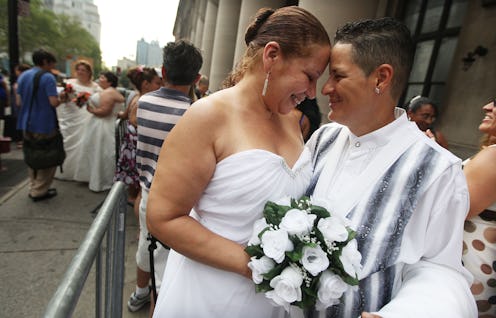News
How Did The U.S. Get Here On Gay Marriage Support?
This is, perhaps, one of the most exciting times in American history: the nation's first black president is on course to finish his second term in the White House and a woman is the frontrunner to succeed that position; marijuana legalization is slowly but surely gaining acceptance across the country; Obamacare has made healthcare affordable for some Americans. But perhaps the most exciting issue on the verge of a breakthrough is same-sex marriage — as SCOTUS prepares to hear arguments on same-sex marriage on Tuesday, a Gallup poll found more gay marriages and domestic partnerships than previously thought, a sign that the issue is very quickly becoming just another fabric of American life.
Released Friday, the poll found that almost two million adults are in a same-sex relationship, of whom 780,000 are married. The surprising results are higher than the evaluations by the U.S. Census Bureau and, strangely, the Centers for Disease Control and Prevention (CDC), The Los Angeles Times reported. The large number is reflective of a growing number of states legalizing same-sex marriage, but none of that would have happened without the remarkable gains in support for same-sex marriage over the past few years.
When Gallup first measured the issue in 1996, the year the Defense of Marriage Act (DOMA) was signed into law, only 27 percent supported same-sex marriage; in 2014, that level was at 55 percent, essentially doubling support from some 20 years ago. The juxtaposition of both these figures are heartening, but how did support for gay marriage change so quickly?
Support has gradually increased each year since 1996, largely attributed to the growing number of Millennials who are "far more open to gay rights than previous generations." According to the Pew Research Center report, among the reasons given by those who changed their minds in favor of gay marriage was that they knew someone who was gay, grew more open-minded or gave the issue more thought, and/or that it was "inevitable."
Gay marriage rights truly took a turn in 2013, the year the Supreme Court struck down DOMA and California's discriminatory Proposition 8 was ruled unconstitutional. Both rulings — but more importantly DOMA — were landmark for the law's recognition of gay rights and made same-sex marriage a part of the national discussion.
When President Obama ran for president in 2008, he opposed same-sex marriage; as did Hillary Clinton. His declaration of support for gay marriage in 2012, risky as it was, indicated that the issue is not as politically divisive as it once used to be. Clinton, too, supports gay marriage now. The fact that politicians feel as though they can express support for the issue is further testament to the growing tide backing same-sex marriage.
Everywhere you look, national progress on gay marriage rights is evident — employers risk being known as discriminatory if they refuse to serve gay people (though that, unfortunately, is still prevalent); discrimination based on sexual orientation is less tolerated than ever before (ahem, Indiana); the rise in same-sex couples means that more people are coming out about their sexuality, which in turn makes their marriages more accepted; even the Republican party, for God's sake (ha ha), is working through their stance on the issue.
Fingers crossed that when SCOTUS rules on same-sex marriage these coming weeks, it will be on the right side of history.
Image: Getty Images (2)
